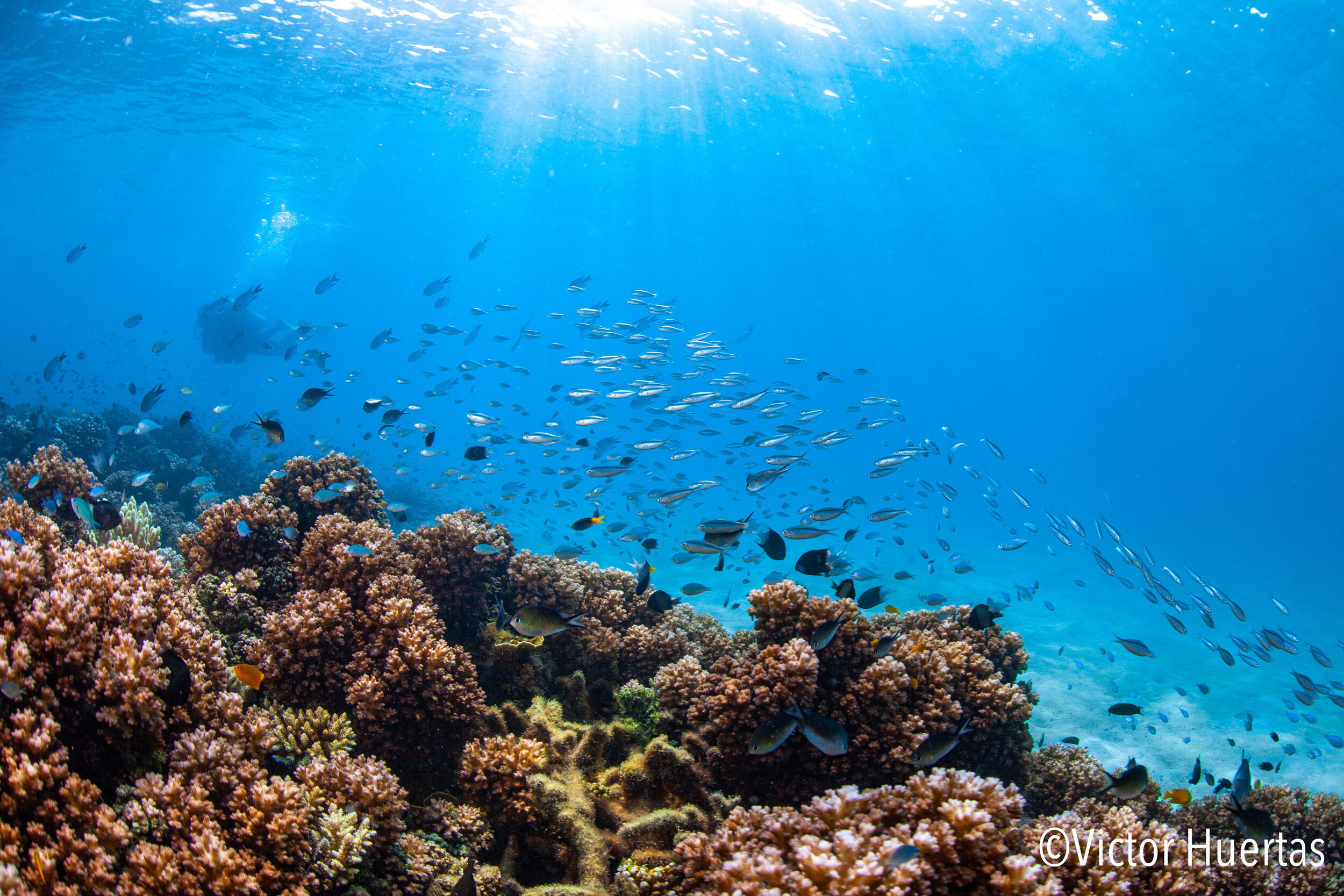New paper: Planktivores drive global coral reef fish diversity
Planktivorous reef fishes Pseudanthias pascalus feed above the coral reefs of French Polynesia.
Photo: Victor Huertas
Biodiversity on coral reefs is not evenly distributed around the globe. It is clustered in hotspots.
The hottest hotspot for corals, fishes and other reef-dwellers is the Indo-Australian Archipelago (IAA). Being such a special location, the IAA has long received attention from researchers aiming to identify why species cluster there in particular.
“The archipelago is one of the most complex and dynamic geological regions in the tropics.
And its fishes underpin its status as a biodiversity hotspot.” - Ale Siqueira
In his final PhD paper, published recently in PNAS, our Post Doc Ale Siqueira (together with co-authors Renato Morais, David Bellwood and Pete Cowman) took a new perspective to this question.
Analyzing the global occurrence of over 3,600 reef fish species, Ale clustered fishes by their trophic group, that is what they feed on. This focus on diet not only allows to understand pathways of nutrients and energy throughout coral reef ecosystems more broadly, it also directly links to possible energetic constraints - an assumed major influence on where biodiversity hotspots can develop.
Fig. 1 Global coral reef fish richness per trophic group. Maps show the absolute number of species per grid cell (n = 2,800) in each classified trophic group. Cell colors correspond to the scale bar and range from low (blue) to intermediate (yellow) and high (red) richness. Grid cell resolution is 150 km2 (see Rabosky et al., 27).
One trophic group stood out - planktivores.
Planktivorous fishes were far more diverse in the IAA than any other feeding group.
On the one hand, this finding reveals that the “hotness” of the hotspot is largely driven by this one group of fishes.
On the other hand, however, Ale found that planktivores were also the group with the steepest drops in biodiversity, when moving further away from the hotspot.
This means, even if planktivores are very successful and diverse within the IAA - and contributing disproportionately to the local and global diversity of reef fishes - their dominance is focused and highly location dependent.
So why is the IAA a particular hotspot for planktivorous species? Co-author David Bellwood says it may be related to disproportional extinctions of planktivores in other regions and to exceptionally stable conditions and food supply within the archipelago:
“The exceptional success of planktivores may be a result of the hotspot’s
unique geological configuration and oceanographic currents,
which ensure a constant and abundant source of planktonic food.
Such stable conditions over the past five million years are likely to have promoted
the accumulation of planktivorous fish species in the hotspot.” - David Bellwood
Fig. 2 Global coral reef fish species richness (A) and proportion (B) per guild with distance from the IAA. (A) Number of species per grid cell (mean [black line] ± 95% CI [colored shading]) predicted from a negative binomial model per trophic group. The inset displays the model coefficient (±95% CI) per trophic group along with the R2 value of each model. Lines in the main figure represent the interaction between mean body size and trophic group; therefore, their perceived inclination may not match the size-independent coefficient represented in the Inset. (B) Proportion of species per grid cell in each trophic group (mean [black line] and interquartile range [colored shading]) predicted from beta regression models. Respective pseudo-R2 values are shown in the top left corners. Semitransparent dots represent sampled grid cells (n = 2,800). Predictions from all models were performed with body size fixed in the estimated value for the cells closer to the center of the IAA. Trophic groups: generalized carnivores, red; herbivores/detritivores, green; mobile invertivores, yellow; omnivores, beige; planktivores, blue; sessile invertivores, brown.
These new findings add a new layer to understanding what creates biodiversity hotspots. Trophic ecology and what fishes eat has previously often been overlooked, yet appears to be an important driver in explaining gradients of species richness around the world.
For Ale, this new perspective, that incorporates ecology and how animals interact with their environment and each other, is critical if we want to understand how species and communities develop through time and space.
Including these process-focused perspectives allows a more in-depth understanding, compared to counting the presence of fish species.
“A deeper understanding of species interactions is needed.
Future research should focus on the ecosystem roles that different species play.
We need to describe changes in the roles of species through space and time,
rather than simply documenting species and their numbers;
the traditional approach in science.” - Ale Siqueira
To find out more about this new perspective on biodiversity and what it means to our understanding of evolution and biogeography, find the full text here - or get in touch with Ale for a copy of the paper.
Planktivorous coral reef fishes feeding in the water column at Lizard Island, Australia.
Photo: Victor Huertas



![Fig. 2 Global coral reef fish species richness (A) and proportion (B) per guild with distance from the IAA. (A) Number of species per grid cell (mean [black line] ± 95% CI [colored shading]) predicted from a negative binomial model per trophic gro…](https://images.squarespace-cdn.com/content/v1/5ecb22699d9c412a9d917ae3/1614747671897-5M51OF5N1LOF6EAISL5N/Siqueira_etal_Fig2.jpg)
